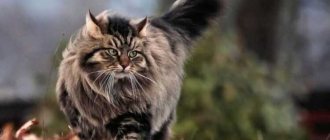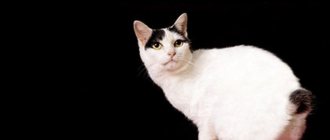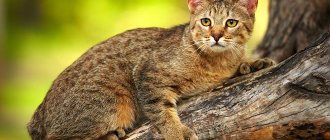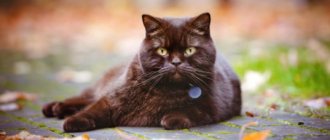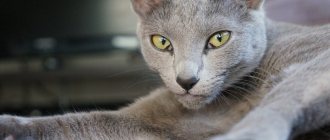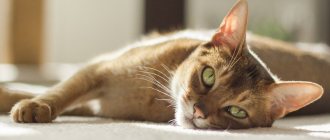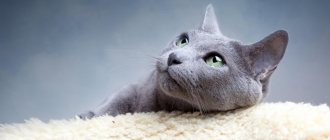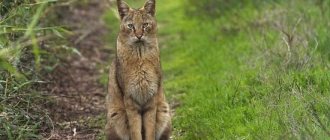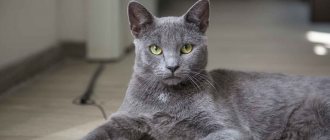History of the origin of the British cat
Judging by the name itself, it becomes clear that the homeland of these cats is Great Britain. Historians suggest that these animals were brought to the British Isles by the ancient Romans around the first century AD.
The main advantage of those ancient representatives of the British was their short and very dense coat, which provided the animals with protection from moisture and harmful insects. It was thanks to this wool that the British quickly got used to and adapted to new living conditions.
They were excellent hunters, thanks to their high levels of endurance and well-developed physical fitness.
Due to their spectacular appearance, at the end of the 16th century, British felines began to be looked at not only as skilled hunters. And already in 1871, British individuals participated in the first cat exhibition in London.
The British - who are they?
Britons are one of the most popular domestic cats in Europe. The breed went through a difficult development path before acquiring its modern appearance. Today they are large (the average weight of a cat is six kilograms), powerful and stocky animals with a large round head, expressive eyes and small ears.
Particular attention is drawn to the luxurious fur with its huge variety of colors and patterns: the famous “plush” for short-haired ones and thick, fluffy for long-haired ones
According to legend, the distant ancestors of modern Britons were brought to Foggy Albion about two thousand years ago by the Romans. It can be assumed that those cats were predominantly wild in color - tabby, but have since changed greatly, crossing with local stock and adapting to the cold climate.
Description of the breed
The main characteristic feature of the British is power, especially when it comes to males. Female cats are smaller in size than male cats. Squat height and rather large size, developed muscles and sternum - this is the image of a modern Briton.
The head of these cats is large with rounded outlines. The muzzle has developed cheeks and cheekbones. Only the British have a pronounced fold of skin around the neck.
The nose is medium long, rather wide. When viewed in profile, you can see that the nose forms a depression in the frontal part. The ears are located quite widely, with a wide base. The shape is rounded, the size of the ears is medium.
British people have large, round eyes. Set wide apart. What distinguishes British cats is the color of their eyes, characteristic of the breed - it is bright orange.
Newborns may have blue eyes, however, over time they will change their color. It is very rare to come across cats with blue or green eyes.
Medium or short llamas are equipped with well-developed strong muscles. The tail is of medium length and looks proportional to the body.
How to choose an unusual kitten
A British shorthair of chocolate color or a fold-eared cat of the same color will have to be selected taking into account the characteristics of the breed.
The English cat is characterized by stable health. Just look at the activity of the kittens, their appetite and curiosity (withdrawal will begin to appear a little later).
If a pair of parent cats is incorrectly selected, the Scottish Fold breed sometimes exhibits osteochondrodysplasia, a congenital hereditary disease of the skeleton and osteochondral system.
Kittens with this disease are afraid of sudden movements that can cause pain. Therefore, you should only buy a fold-eared kitten from a nursery or from a breeder with a good reputation.
It is useful to get to know the parents and, if possible, to look at their grown-up children from other litters. As a rule, the same pair consistently produces almost identical offspring.
Looking at them, you can predict the color, size, and even the character of newborn kittens.
A British Shorthair kitten is recommended for people who work a lot and are rarely at home. An hour and a half is enough for them to fully satisfy the need for communication with their pet. And the British also like this daily routine.
Scots are great for homebodies, families with children, and those who enjoy endless cat games. And the brown color always evokes the admiration of guests and a sense of pride among the owners. And the cats themselves are imbued with their own uniqueness and are happy to show off their rich, thick fur the color of fragrant British chocolate.
I like it I don't like it
Animal mating
Representatives of this breed belong to individuals with a late indicator of the development of reproductive systems.
Therefore, knitting a cat in its first year of life is strictly prohibited, because the animal may simply die. The body completes full development only by the age of 6 years.
Early mating of males before 2 years of age can lead to exhaustion, so in the future they will not be able to produce offspring.
British kittens are born completely similar to adults. Physiological features in the form of a disproportionate body are the norm for kittens. Over time, everything will return to normal, and the kitten will take on the appearance of a standard British cat.
Oriental cat - history of the breed, modern standards, character, care, nutrition + 83 photos- Maine Coon - history of occurrence, description of the breed, character + 84 photos
- Burma - a cat as a mascot, hygiene and health, character of the breed + 96 photos
Caring for a Blue Briton
Animal care should be carried out in several directions:
- The British coat is combed with special brushes with metal or rubber bristles that are not rough and do not damage the skin. Kittens should be taught to brush themselves from a young age - then the animal will definitely begin to treat the procedure patiently and even accept it with gratitude. Particular attention should be paid to this during the cat’s molting period - this will additionally avoid the spread of hair on carpets and upholstery and help speed up this process. Remains of fur after the procedure can be removed with wet hands or a special rubber glove. But bathing is a completely optional procedure for an animal, but if your youngest family member manages to get very dirty, then just wash him under running warm water with a special shampoo.
- Kittens and adult animals may have discharge around their eyes, which can be simply removed with a cotton swab and eye wash solution, but keep in mind that the appearance of purulent discharge is a signal that the animal urgently needs to be examined by a veterinarian
- The auricle of a healthy animal is uniform in color, clean, and odorless. If you have a problem cleaning the ear, just use a cotton swab soaked in the solution intended for this, but do not be zealous to prevent any foreign objects from getting into the ear canal.
In general, the breed has good and stable immunity and is not susceptible to special diseases with proper care, just do not forget to look closely at your pet and changes in its behavior and character, because if your cat gets sick, he will definitely try to tell you about his illness in the only way available to him language - behavior.
Making the right menu for your pet
Below is a description of how to feed a British cat. The growing body of small kittens up to 1.5-2 months requires food up to five times a day; an older pet, up to six months, is offered food three times a day. As your pet gets older, you need to be taught to eat twice a day, as an adult animal should.
Of course, in between feedings, you can treat the animal with its favorite “snack” as a reward. However, overfeeding a cat leads to obesity and a reduction in its lifespan.
It makes sense to give blue Britons vitamins, preferably in courses, which your veterinarian or consultant at a specialized pet store will help you choose.
The kitten can be fed with ready-made food, natural products, or a combination of both:
- Feeding with special prepared foods. There are many ready-made foods for cats and kittens that you can offer your pet. It is worth choosing from well-known companies of special food for cats; in no case should you give preference to advertised food like Whiskas - such food contains many harmful additives, and the main component - protein - is made from dubious products, such as skins and bones of carcasses.
- Feeding with natural food. If you decide to feed your British cat “natural” products, then first of all remind yourself that a cat is a carnivorous animal, and therefore it has every right not to eat your “that delicious soup.” Try to give your predator foods rich in animal proteins. Meat and offal must be frozen. Food should be at room temperature and always unsalted. Do not add too much fish to your diet, as this can lead to urolithiasis and kidney disease. It is better to completely remove fish from the diet of castrated cats.
- Complex feeding. You can also treat your pet to a complex diet, using dry food as a basis, and natural meat or fish products as an additional supplement.
Sorry, there are no surveys available at this time.
And remember: the best thing you can give your pet is care and love!
Character of the breed
The description of the character of the British cat says that these animals are suitable for people who spend little time within the walls of the house. These felines can cope just fine without human attention.
The British have a calm, aristocratic disposition. Even from the photo of a British cat it is clear that they know their worth and have a sense of unsurpassed dignity.
Along with this, they are very friendly and not aggressive. If they are often offended, they become withdrawn and unsociable.
If there is a child in the house, then such a cat will not be suitable for him as a fluffy toy. Otherwise, she will simply hide. British individuals get along well with other animals.
What to feed them
British cats are prone to obesity, which should not be allowed. Excess weight and a sedentary lifestyle will lead to poor health of animals and the development of diseases. You should not accustom them to flour and sweets, give them food from the table and allow them to beg.
The diet may consist of dry food or food prepared by you. When choosing dry food, strictly follow the instructions for choosing the amount of food. Remember, the package indicates the amount of food per day. Choose your own food for each age. The packaging indicates two numbers for the consumption rate in grams.
The first number is the amount of food for sedentary and inactive cats, the second number, on the contrary, is for active cats who walk outside for at least 3 hours. Do not mix dry food with table feeding. The fact is that dry food is made taking into account the correct balance in daily nutrition, with the addition of vitamins, nutrients, etc. If you overfeed your cat, the excess will be deposited in the form of fat on the animal’s ribs or stones will form in the genitourinary system.
When compiling your own diet, determining the daily intake will be somewhat more difficult. When developing a menu, consider the following characteristics of your pet: age, activity level, living conditions and weight. If you have a kitten, you need to feed it 2 times more often and more than a cat over 3 years old. A kitten can be compared to a small child who needs a lot of vitamins and high-calorie food, since a lot of energy is spent on its development and during play. Therefore, nothing is deposited on the ribs.
With an active lifestyle, the animal needs a lot of vitamins and nutrients consumed throughout the day. Also, the daily consumption rate should be higher than usual if the cat does not live at home during the winter, near the radiator, but in an unheated room.
Check your pet regularly for signs of excess weight. First of all, check for the presence of fat on the lower abdomen, between the hind legs. Secondly, feel the ribs. You should start worrying about the problem of obesity if you feel a fatty layer on the ribs. Another way to determine body fat is when the animal's body has acquired a square shape.
To solve the problem of obesity, gradually reduce the amount of food you eat. Cats eating dry food need to reduce the daily intake to 3-4 times over 1-2 weeks. At the same time, monitor its condition and appearance. The main thing is not to overdo it. Go see a veterinarian. He will advise what to feed a British breed cat to treat obesity. In veterinary stores you can buy special low-calorie food for the “diet” period. They will not allow the fat layer to accumulate without reducing the volume of feed given.
When creating your own diet, exclude fatty, sweet, flour products such as semolina, pasta, millet cereals, etc. Include lean beef, vegetables, dairy products and low-calorie cereals such as oatmeal, millet and corn chaff in your diet. The volume of previously consumed food is reduced to 2 times. The ideal option is a combination of diet and exercise.
Photo of a British cat
Life needs
The British don't worry too much about the conditions in which they live - as long as they have loving owners who take the time to communicate with them. They strike a balance between being playful and just wanting to snooze in the sun all day. This means your cat will always be ready to play chasing the little red laser beam, but you won't have to worry about him getting into trouble while you're at work (especially if you leave plenty of toys for him to enjoy).
Like most cats, Britons enjoy cat trees to stretch and climb on.
